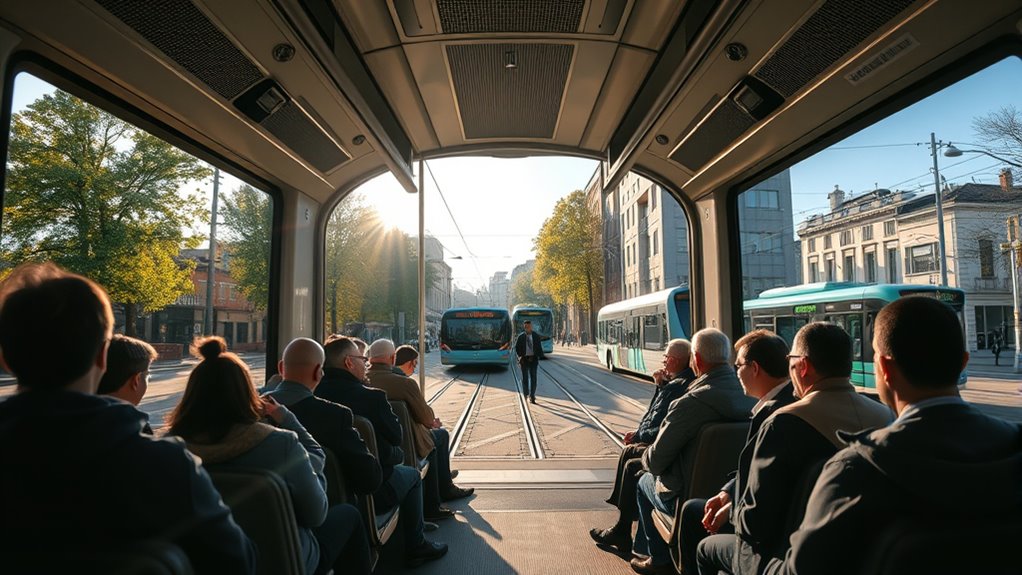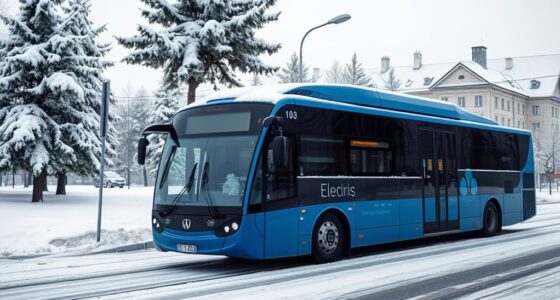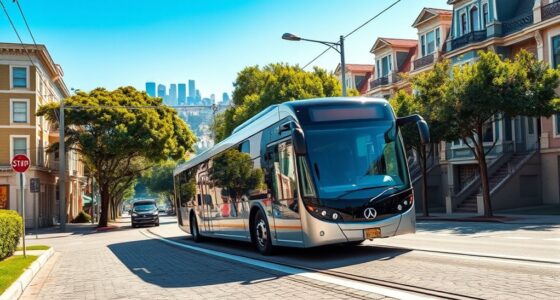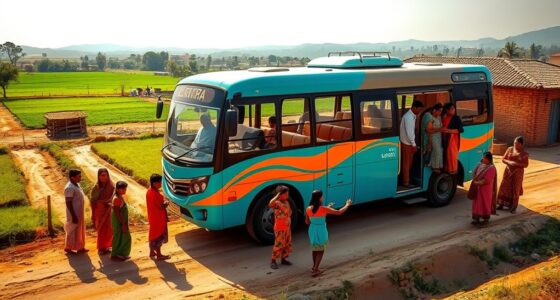In Oslo, you’ll notice cleaner air and quieter streets thanks to the city’s focus on sustainable transit. Electric buses run silently, reducing local pollution, while expanded bike lanes make cycling safer and easier. These efforts help cut traffic noise and emissions, creating a more pleasant environment for everyone. If you want to discover how Oslo’s transportation system is transforming daily commutes and making the city more livable, there’s much more to explore.
Key Takeaways
- Passengers notice significantly reduced air pollution and fumes at bus stops due to electric buses’ zero emissions.
- Commuters experience quieter streets and transit environments thanks to electric buses and active transportation options.
- The extensive, well-maintained bike lanes encourage cycling, decreasing vehicle emissions and noise in urban areas.
- The shift to sustainable transit improves overall urban air quality, leading to healthier, more pleasant city living.
- Infrastructure developments support cleaner, quieter commuting, fostering a greener, more sustainable Oslo community.
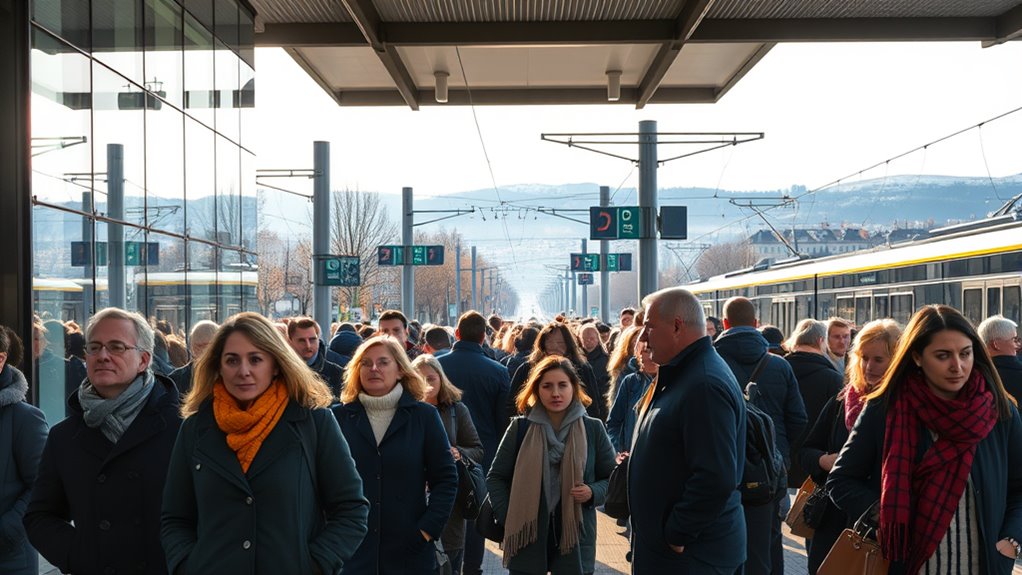
Commuting in Oslo offers a seamless blend of efficiency and sustainability that makes everyday travel straightforward. You’ll find that the city’s transportation system is designed to prioritize clean energy and eco-friendly options, making your daily commute less stressful and more environmentally conscious. Electric buses are a key part of this effort. These buses run quietly, emit zero tailpipe emissions, and are often more comfortable than traditional diesel-powered vehicles. With their bright, modern designs, electric buses glide smoothly along designated routes, providing reliable service throughout the city and its suburbs. You’ll notice fewer fumes at bus stops, and the air feels cleaner, especially during peak hours. The city’s investment in electric buses demonstrates its commitment to reducing air pollution and greenhouse gases, so you can feel good about choosing public transit. Additionally, the integration of renewable energy sources to power these buses further enhances their environmental benefits.
In addition to electric buses, Oslo has invested heavily in creating extensive bike lanes that make cycling a safe and attractive option for daily commuting. You’ll find dedicated bike lanes separated from vehicle traffic on many major roads, which helps keep cyclists safe while encouraging more people to pedal instead of drive. The city has prioritized expanding these lanes, making it easier to navigate through neighborhoods, commercial districts, and along scenic routes. When you opt to bike, you enjoy the fresh air, avoid traffic jams, and contribute to lowering your carbon footprint. The bike lanes are well-marked and maintained, so you won’t have to worry about uneven surfaces or dangerous intersections. Plus, the city’s bike-sharing schemes make it simple to rent a bike when you need one, whether for a quick trip or a longer ride. This network of bike lanes and bike-sharing programs creates a practical, eco-friendly alternative to driving, encouraging more residents and visitors to choose cycling for their daily commute.
Together, electric buses and bike lanes form the backbone of Oslo’s sustainable transportation system. You no longer have to endure long, noisy waits in traffic or breathe in exhaust fumes. Instead, you can enjoy a quieter, cleaner environment as you get to your destination. Whether you’re hopping on a modern electric bus or pedaling along dedicated bike lanes, the city’s infrastructure supports your choice of greener, healthier travel options. As Oslo continues to improve these systems, your daily commute becomes not just a necessity, but an opportunity to reduce your environmental impact while enjoying the city’s vibrant, open spaces. This focus on sustainable transit makes commuting in Oslo not only efficient but also a positive step toward a cleaner, quieter future for everyone.
Frequently Asked Questions
How Has Oslo Reduced Vehicle Emissions in Recent Years?
You’ve seen Oslo reduce vehicle emissions by promoting electric vehicle adoption and implementing congestion pricing. These measures encourage people to switch to cleaner electric cars and discourage car use during peak times, which cuts down air pollution and traffic. By making driving more expensive during busy hours, Oslo motivates residents to choose public transport, bike, or walk, helping to create cleaner air and quieter streets for everyone.
What Incentives Encourage Oslo Residents to Choose Public Transportation?
You’re encouraged to choose public transportation in Oslo through incentives like promoting electric vehicle adoption and expanding car sharing programs. These initiatives make it easier and more affordable for you to opt for buses, trams, and trains. By supporting electric options and sharing rides, you help reduce emissions and traffic, making your commute cleaner and quieter. The city’s efforts aim to create a sustainable, convenient transit experience that benefits everyone.
Are There Plans to Expand Cycling Infrastructure in Oslo?
Yes, Oslo plans to expand its cycling infrastructure considerably. You’ll see more bike lanes weaving through the city and new pedestrian zones that make cycling safer and more appealing. This effort complements existing infrastructure, encouraging you to choose biking over driving, especially in areas where you can enjoy the vibrant street life. The city’s focus on safe, accessible routes shows its commitment to sustainable, healthy urban mobility.
How Does Oslo Monitor Air Quality Improvements?
Oslo monitors air quality through a network of sensors placed around the city, tracking pollutants like NO2 and PM10. You can access real-time data online to see improvements. The city’s initiatives, such as introducing electric buses and expanding pedestrian zones, help reduce emissions. These measures allow you to experience cleaner air and quieter streets, making your daily commute healthier and more enjoyable.
What Challenges Remain for Sustainable Commuting in Oslo?
Think of Oslo as a carefully crafted puzzle; challenges like urban planning hurdles and limited infrastructure still stand. You need to actively promote community engagement to transform these obstacles into opportunities for sustainable commuting. You might face resistance to change or gaps in public transit options. Addressing these issues requires ongoing collaboration, innovative solutions, and a shared vision to make the city’s future greener, cleaner, and more accessible for everyone.
Conclusion
As you step into Oslo’s tranquil streets, you can feel the city breathing easier, like a gentle giant finally exhaling. The cleaner air and quieter lanes invite you to slow down and savor the moment. It’s as if the city’s heartbeat has softened, welcoming you into a calmer, greener rhythm. So next time you commute, remember—you’re not just moving through a city, but part of a quiet revolution that’s shaping a brighter, fresher tomorrow.
